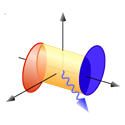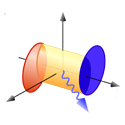The shortest known photon pulses
Interest in performing spectroscopy with enough spatial and temporal resolution to track atomic and molecular motion is pushing scientists to generate ultrafast photon pulses. Although lasers are normally the focus of this effort, some of the shortest known photon pulses are actually produced in high-energy atomic collisions, particularly those that occur in the formation of the quark-gluon plasma (QGP). This new state of matter is produced over nuclear sizes femtometers ( ) and lasts up to a few yoctoseconds ( ).
Writing in Physical Review Letters, Andreas Ipp, Christoph H. Keitel, and Jörg Evers at the Max Planck Institute for Nuclear Physics in Heidelberg, Germany, model the photon emission from the QGP and predict that pulses on the yoctosecond scale should occur. These shortest of pulses have energies in the GeV range and can potentially be used to perform ultrafast time-resolved experiments in atomic and nuclear physics. Another significance of the work lies in its potential to shed new light on the equilibration processes that occur in the QGP, many aspects of which are still poorly understood. – Abhishek Agarwal





